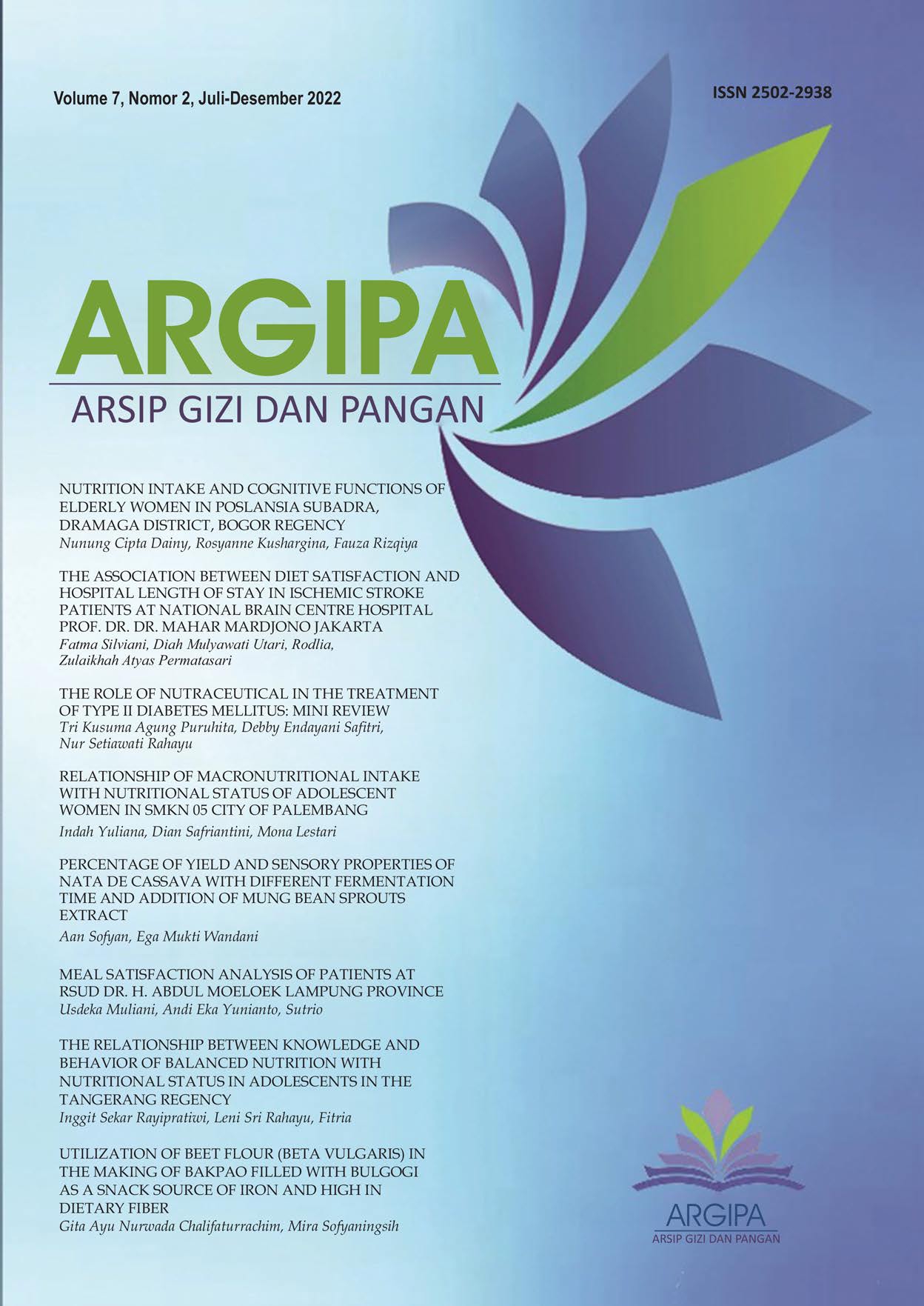Percentage of yield and sensory properties of nata de cassava with different fermentation time and addition of mung bean sprouts extract
DOI:
https://doi.org/10.22236/argipa.v7i2.9369Keywords:
Fermentation, Mung Bean Sprout, Nata de Cassava, Sensory Properties, YieldAbstract
Nata is a food product that is widely known by the public, but nata is commonly made using coconut water which is fermented by the bacterium Acetobacter xylinum. It needs to be a diversification process of making nata by utilizing other substrates, namely cassava extract. This study aims to determine the effect of fermentation time and the addition of mung bean sprout extract on the yield, as well as the sensory properties of nata de cassava. The research method used is experimental research with a research design in the form of a completely randomized design (CRD). There were two types of treatment in this study, namely variations in fermentation time of 9, 11, and 13 days, and variations in the addition of mung bean extract sprout of 0.75%, 1%, and 1.25%. The results showed that the highest yield was 86.2% in the 9-day fermentation treatment with the addition of 0.75% mung bean extract, while the lowest yield was 12.1% at the 13-day fermentation time with the addition of mung bean sprout extract 1. 25%. The best sensory properties of nata de cassava as a whole were at 11 days of fermentation with the addition of 1% mung bean sprout extract. This study concludes that there is no effect of fermentation time and the addition of different green bean sprout extracts on the nata de cassava yield.
Downloads
References
Alfarisi, C. D., Yelmida, Zahrina, I., & Mutamima, A. (2021). Pembuatan nata de cassava dari limbah cair tapioka dengan menggunakan sumber nitrogen alami yang berbeda. Jurnal Ilmiah Pertanian, 17(2), 93–100. https://doi.org/10.31849/jip.v17i2.6208
Anam, C. (2019). Mengungkap Senyawa pada Nata De Coco sebagai Pangan Fungsional. Jurnal Ilmu Pangan Dan Hasil Pertanian, 3(1), 42–53. https://doi.org/10.26877/jiphp.v3i1.3453
BPS. (2021). Hasil Sensus Penduduk 2020. Berita Resmi Statistik, 7, 1–8. https://www.bps.go.id/pressrelease/2021/01/21/1854/hasil-sensus-penduduk-2020.html
Gresinta, E., Pratiwi, R. D., Damayanti, F., & Putra, E. P. (2019). Komparasi Yield Nata De Tomato Dengan Nata De Coco Berdasarkan Lama Fermentasi. IJIS Edu"¯: Indonesian Journal of Integrated Science Education, 1(2), 169–174. https://doi.org/10.29300/ijisedu.v1i2.2248
Hamad, A., & Kristiono. (2013). Pengaruh Penambahan Sumber Nitrogen Terhadap Hasil Fermentasi Nata De Coco. Jurnal Momentum, 9(1), 63–65. https://media.neliti.com/media/publications/113764-ID-none.pdf
Layuk, P., Joseph, M. L. D. A. N. G. H., & Coco, N. De. (2016). Pengaruh Waktu Fermentasi Air Kelapa Terhadap Produksi dan Kualitas Nata de Coco. Buletin Palma, 13(1), 41–45.
Lubis, A. W., & Harahap, D. N. (2018). Pemanfaatan Sari Buah Naga Super Merah ( Hylocereus Costaricensis ) Pada Pembuatan Nata De Coco Terhadap Mutu Fisik Nata. Journal of Chemistry, Education, and Science, 2(2), 1–10. https://jurnal.uisu.ac.id/index.php/CHEDS/article/download/903/779
Marvie, I., & Sunarti, T. C. (2021). Pemanfaatan Selulosa Frond Sagu untuk Produksi Hidrolisat Prebiotik Melalui Hidrolisis Enzimatis. Journal of Science, Technology, and Virtual Science, 1(3), 155–163. https://www.researchgate.net/publication/358117226_Pemanfaatan_Selulosa_Frond_Sagu_untuk_Produksi_Hidrolisat_Prebiotik_Melalui_Hidrolisis_Enzimatis
Nurdyansyah, F., & Widyastuti, D. A. (2017). Pengolahan Limbah Air Kelapa Menjadi Nata De Coco Oleh Ibu Kelompok Tani Di Kabupaten Kudus. 21(XI), 22–30. https://jurnal.uns.ac.id/kewirausahaan-dan-bisnis/article/viewFile/20900/16254
Putranto, K., & Taofik, A. (2017). Penambahan Ekstrak Toge Pada Media Nata De Coco. Agroteknologi, 10(2), 138–149. https://journal.uinsgd.ac.id/index.php/istek/article/download/1484/1045
Putri, A. N., & Fatimah, S. (2021). Karakteristik Nata De Soya Dari Limbah Cair Tahu dengan Pengaruh Penambahan Ekstrak Jeruk Nipis dan Gula. IJCA (Indonesian Journal of Chemical Analysis), 4(2), 47–57. https://doi.org/10.20885/ijca.vol4.iss2.art1
Putriana, I., & Aminah, S. (2013). Mutu fisik, kadar serat dan sifat organoleptik nata de cassava berdasarkan lama fermentasi. Jurnal Pangan Dan Gizi, 4(7), 116149. https://jurnal.unimus.ac.id/index.php/JPDG/article/view/1061/1110
Santosa, B., Ahmadi, K., & Taeque, D. (2012). Dextrin Concentration and Carboxy Methyl Cellulosa ( CMC ) in Making of Fiber-Rich Instant Baverage from Nata de Coco. IEESE International Journal Of Science and Technology (IJSTE), Vol. 1(No. 1), 6–11. http://citeseerx.ist.psu.edu/viewdoc/download?doi=10.1.1.248.1185&rep=rep1&type=pdf
Saptaria, L., & Nurhidayati, N. (2017). Analisis Peramalan Permintaan Produk Nata De Coco Untuk Mendukung Perencanaan Dan Pengendalian Produksi Dalam Supply Chain Dengan Model Cpfr (Collaborative Planning, Forecasting, And Replenishment). Jurnal Nusamba, V(2), 130–141. https://ojs.unpkediri.ac.id/index.php/manajemen/article/view/924
Sharif, M. K., Butt, M. S., Sharif, H. R., & Nasir, M. (2017). Sensory Evaluation and Consumer Acceptability. Handbook of Food Science and Technology, October, 362–386. https://www.researchgate.net/publication/320466080_Sensory_Evaluation_and_Consumer_Acceptability
Singh-Ackbarali, D., & Maharaj, R. (2014). Sensory Evaluation as a Tool in Determining Acceptability of Innovative Products Developed by Undergraduate Students in Food Science and Technology at The University of Trinidad and Tobago. Journal of Curriculum and Teaching, 3(1), 10–27. https://doi.org/10.5430/jct.v3n1p10
Suryana, A. (2014). Menuju Ketahanan Pangan Indonesia Berkelanjutan 2025: Tantangan dan Penanganannya. Forum Penelitian Agro Ekonomi, 32(2), 123. https://doi.org/10.21082/fae.v32n2.2014.123-135
Zhi, R., Zhao, L., & Shi, J. (2016). Improving the sensory quality of flavored liquid milk by engaging sensory analysis and consumer preference. Journal of Dairy Science, 99(7), 5305–5317. https://doi.org/10.3168/jds.2015-10612

















